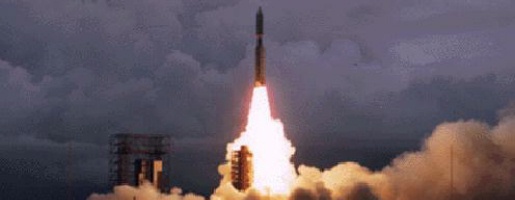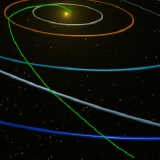 |
|||||||||||||||||||
|
The
launch of Voyager 1.
|
|||||||||||||||||||
| VOYAGER MISSIONS | |||||||||||||||||||
| Once every 175 years, there is an alignment of the planets Jupiter, Saturn, Uranus and Neptune that allows a spacecraft to swing by each one, using each planet's gravity to propel it on to the next. The Voyager missions were designed to be a Grand Tour taking advantage of the planetary alignment. | |||||||||||||||||||
| The Voyagers are identical spacecraft. Each caries instruments to conduct 10 different experiments - television cameras, infrared and ultraviolet sensors, magnetometres, plasma detectors, and cosmic-ray and charged-particle sensors. The two spacecraft were programmable. That is, new computer instructions could be received and executed during the flight. When the Voyagers arrived at the gas giants they were smarter than when they left Earth. | |||||||||||||||||||
|
|||||||||||||||||||
| The flightpath chosen for Voyager 1 was designed to send the spacecraft past Saturn's moon Titan and behind the rings. This however meant that Voyager 1 would leave the Saturn system headed upwards out of the plane of the Solar System, with no possibility of further planetary exploration. | |||||||||||||||||||
 Voyager 1 left the plane of the Solar System after the Saturn encounter. Voyager 2 was sent on a course that would cause it to be deflected by Saturn's gravity, and be given a boost towards Uranus. A further gravitational assist at Uranus sent Voyager 2 on to an encounter with Neptune. |
 Voyager 2 encountered all four gas giants before leaving the plane of the Solar System. |
||||||||||||||||||
| The planetary alignment that made the Voyager mission possible did not include Pluto. Once Voyager 2 had left the Neptune system, its flightpath was to take it in a direction towards inter-stellar space without visiting Pluto. | |||||||||||||||||||
| Today, both Voyagers are still travelling towards the stars. Voyager 1 is increasing its distance by about 520 million kilometres per year, climbing higher above the plane of the Solar System. Voyager 2 is below the plane, and increasing distance by about 470 million kilometres per year. The Voyagers are still operational, as they do not use solar panels and do not need sunlight to remain powered. Rather, they each have a nuclear battery (radioisotope thermoelectric generator), and will continue to make measurements of their environment until the power fails. Power failure is estimated to be between 20 and 30 years from now. The next encounter the Voyagers will make will be with the heliopause, the boundary where the solar wind stops and the inter-stellar medium starts. Whether or not the Voyagers will be alive and capable of reporting the discovery remains to be seen. | |||||||||||||||||||
| The Voyager mission ranks as one of the most successful space missions ever. The data and images returned from each planetary encounter are still the best we have of many of the small moons, rings, and planetary atmospheres. Voyager data is the basis for much of today's planetary science. | |||||||||||||||||||
|
|
|||||||||||||||||||